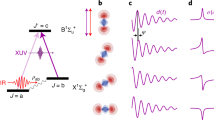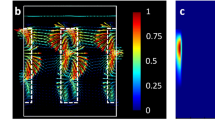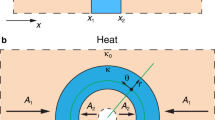Abstract
Emission and absorption of light lie at the heart of light–matter interaction1. Although emission and absorption rates are regarded as intrinsic properties of atoms and molecules, various ways to modify these rates have been sought in applications such as quantum information processing2, metrology3 and light-energy harvesting4. One promising approach is to utilize collective behaviour of emitters in the same way as in superradiance5. Although superradiance has been observed in diverse systems3,6,7,8,9,10, its conceptual counterpart in absorption has never been realized11 until now. Here we demonstrate enhanced cooperative absorption—superabsorption—by implementing a time-reversal process of superradiance. The observed superabsorption rate is much higher than that of ordinary absorption, with the number of absorbed photons scaling with the square of the number of atoms, exhibiting the cooperative nature of superabsorption. The present superabsorption—which performs beyond the limitations of conventional absorption—can facilitate weak-signal sensing1, light-energy harvesting11 and light–matter quantum interfaces2.
This is a preview of subscription content, access via your institution
Access options
Access Nature and 54 other Nature Portfolio journals
Get Nature+, our best-value online-access subscription
$29.99 / 30 days
cancel any time
Subscribe to this journal
Receive 12 print issues and online access
$209.00 per year
only $17.42 per issue
Buy this article
- Purchase on Springer Link
- Instant access to full article PDF
Prices may be subject to local taxes which are calculated during checkout




Similar content being viewed by others
Data availability
The data that support the plots within this paper and other findings of this study are available from the corresponding author on reasonable request. Source data are provided with this paper.
Code availability
All data are obtained from the experiments or from analytic formulae discussed in the manuscript. No special computer codes were used to generate the results reported in this paper.
References
Konstantatos, G. & Sargent, E. H. Nanostructured materials for photon detection. Nat. Nanotechnol. 5, 391–400 (2010).
Hammerer, K., Sørensen, A. S. & Polzik, E. S. Quantum interface between light and atomic ensembles. Rev. Mod. Phys. 82, 1041 (2010).
Norcia, M. A., Winchester, M. N., Cline, J. R. & Thompson, J. K. Superradiance on the millihertz linewidth strontium clock transition. Sci. Adv. 2, e1601231 (2016).
Olaya-Castro, A., Lee, C. F., Olsen, F. F. & Johnson, N. F. Efficiency of energy transfer in a light-harvesting system under quantum coherence. Phys. Rev. B 78, 085115 (2008).
Dicke, R. H. Coherence in spontaneous radiation processes. Phys. Rev. 93, 99–110 (1954).
Skribanowitz, N., Herman, I., MacGillivray, J. & Feld, M. Observation of Dicke superradiance in optically pumped HF gas. Phys. Rev. Lett. 30, 309 (1973).
Gross, M. & Haroche, S. Superradiance: an essay on the theory of collective spontaneous emission. Phys. Rep. 93, 301–396 (1982).
Casabone, B. et al. Enhanced quantum interface with collective ion-cavity coupling. Phys. Rev. Lett. 114, 023602 (2015).
Mlynek, J., Abdumalikov, A., Eichler, C. & Wallraff, A. Observation of Dicke superradiance for two artificial atoms in a cavity with high decay rate. Nat. Commun. 5, 5186 (2014).
Kim, J., Yang, D., Oh, S.-h & An, K. Coherent single-atom superradiance. Science 359, 662–666 (2018).
Higgins, K. et al. Superabsorption of light via quantum engineering. Nat. Commun. 5, 4705 (2014).
Inouye, S. et al. Superradiant Rayleigh scattering from a Bose–Einstein condensate. Science 285, 571–574 (1999).
Reimann, R. et al. Cavity-modified collective Rayleigh scattering of two atoms. Phys. Rev. Lett. 114, 023601 (2015).
Angerer, A. et al. Superradiant emission from colour centres in diamond. Nat. Phys. 14, 1168 (2018).
Neuzner, A., Körber, M., Morin, O., Ritter, S. & Rempe, G. Interference and dynamics of light from a distance-controlled atom pair in an optical cavity. Nat. Photon. 10, 303–306 (2016).
Tighineanu, P. et al. Single-photon superradiance from a quantum dot. Phys. Rev. Lett. 116, 163604 (2016).
Roof, S., Kemp, K., Havey, M. & Sokolov, I. Observation of single-photon superradiance and the cooperative Lamb shift in an extended sample of cold atoms. Phys. Rev. Lett. 117, 073003 (2016).
Scully, M. O. & Svidzinsky, A. A. The super of superradiance. Science 325, 1510–1511 (2009).
Kuzmich, A. et al. Generation of nonclassical photon pairs for scalable quantum communication with atomic ensembles. Nature 423, 731–734 (2003).
Romero, E., Novoderezhkin, V. I. & van Grondelle, R. Quantum design of photosynthesis for bio-inspired solar-energy conversion. Nature 543, 355–365 (2017).
Celardo, G. L., Borgonovi, F., Merkli, M., Tsifrinovich, V. I. & Berman, G. P. Superradiance transition in photosynthetic light-harvesting complexes. J. Phys. Chem. C 116, 22105–22111 (2012).
Kaluzny, Y., Goy, P., Gross, M., Raimond, J. M. & Haroche, S. Observation of self-induced Rabi oscillations in two-level atoms excited inside a resonant cavity: the ringing regime of superradiance. Phys. Rev. Lett. 51, 1175 (1983).
Rose, B. C. et al. Coherent Rabi dynamics of a superradiant spin ensemble in a microwave cavity coherent Rabi dynamics of a superradiant spin ensemble in a microwave cavity. Phys. Rev. X 7, 031002 (2017).
Chong, Y. D., Ge, L., Cao, H. & Stone, A. D. Coherent perfect absorbers: time-reversed lasers. Phys. Rev. Lett. 105, 053901 (2010).
Wenner, J. et al. Catching time-reversed microwave coherent state photons with 99.4% absorption efficiency. Phys. Rev. Lett. 112, 210501 (2014).
Lee, M. et al. Three-dimensional imaging of cavity vacuum with single atoms localized by a nanohole array. Nat. Commun. 5, 3441 (2014).
Reiserer, A., Ritter, S. & Rempe, G. Nondestructive detection of an optical photon. Science 342, 1349–1351 (2013).
Fiedler, S. E., Hese, A. & Ruth, A. A. Incoherent broad-band cavity-enhanced absorption spectroscopy. Chem. Phys. Lett. 371, 284–294 (2003).
Julsgaard, B., Sherson, J., Cirac, J. I., Fiurášek, J. & Polzik, E. S. Experimental demonstration of quantum memory for light. Nature 432, 482–486 (2004).
Haroche, S., Brune, M. & Raimond, J.-M. Measuring the photon number parity in a cavity: from light quantum jumps to the tomography of non-classical field states. J. Mod. Opt. 54, 2101–2114 (2007).
Acknowledgements
This work was supported by Samsung Science and Technology Foundation (project no. SSTF-BA1502-05), National Research Foundation (grant no. 2020R1A2C3009299) and the Ministry of Science and ICT of Korea under ITRC programme (grant no. IITP-2019-2018-0-01402).
Author information
Authors and Affiliations
Contributions
D.Y. and K.A. conceived the experiment. D.Y. performed experiments with help from S.O., J.H. and G.S. D.Y. analysed the data and carried out theoretical investigations with help from J.U.K. K.A. supervised overall experimental and theoretical works. D.Y. and K.A. wrote the manuscript. All authors participated in discussions.
Corresponding author
Ethics declarations
Competing interests
The authors declare no competing interests.
Additional information
Peer review information Nature Photonics thanks Erik Gauger, Stefan Rotter and the other, anonymous, reviewer(s) for their contribution to the peer review of this work.
Publisher’s note Springer Nature remains neutral with regard to jurisdictional claims in published maps and institutional affiliations.
Supplementary information
Supplementary Information
Supplementary Notes 1–12 and Figs. 1–6.
Source data
Source Data Fig. 1
Source data for Fig. 1 in the main text.
Source Data Fig. 2
Source data for Fig. 2 in the main text.
Source Data Fig. 3
Source data for Fig. 3 in the main text.
Source Data Fig. 4
Source data for Fig. 4 in the main text.
Rights and permissions
About this article
Cite this article
Yang, D., Oh, Sh., Han, J. et al. Realization of superabsorption by time reversal of superradiance. Nat. Photonics 15, 272–276 (2021). https://doi.org/10.1038/s41566-021-00770-6
Received:
Accepted:
Published:
Issue Date:
DOI: https://doi.org/10.1038/s41566-021-00770-6
This article is cited by
-
Frequency pushing enhanced by an exceptional point in an atom–cavity coupled system
Scientific Reports (2024)
-
A photonic quantum engine driven by superradiance
Nature Photonics (2022)
-
Superabsorption by time-reversing superradiance
Nature Photonics (2021)
-
Hyperradiance by a stream of phase-correlated atomic dipole pairs traversing a high-Q cavity
Scientific Reports (2021)



